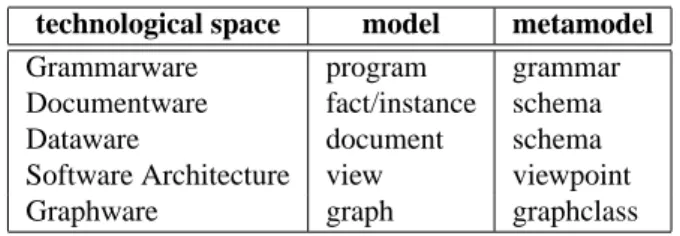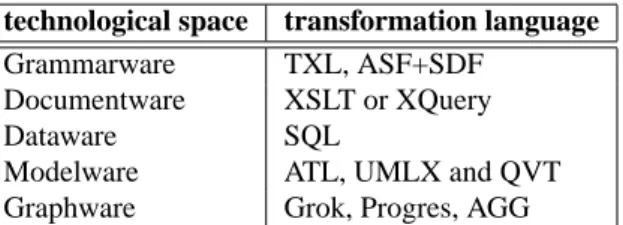Second International Workshop on
Meta-Models and Schemas for Reverse Engineering ateM 2004
— Integrating Reverse Engineering and Model Driven Engineering —
Jean-Marie Favre University of Grenoble
France
www-adele.imag.fr/˜jmfavre/
Jean-Marie.Favre@imag.fr
Mike Godfrey University of Waterloo
Canada
plg.uwaterloo.ca/˜migod/
migod@uwaterloo.ca
Andreas Winter
University of Koblenz-Landau Germany
www.uni-koblenz.de/˜winter/
winter@uni-koblenz.de
Abstract
The International Workshops on Meta-Models and Schemas for Reverse Engineering aim at utilizing meta- technology for the development and use of reverse engi- neering toolsets. The focus of ateM 2004 is the integration of meta-technology of model driven engineering into re- verse engineering.
1. Model Driven Engineering
Model Driven Engineering (MDE) approaches are becom- ing increasingly popular in industry. The Model Driven Ar- chitecture (MDA) [7] standard from the OMG is a specific incarnation of MDE concepts. By contrast, MDE itself is an open and integrative approach that embraces many other Technological Spaces [3] in a uniform way. The emphasis of MDE is on bridges between Technological Spaces and on reuse and integration of various bodies of knowledge devel- oped by different research communities. Examples of tech- nological spaces include Grammarware, with BNF as a pos- sible representative, Documentware and XML, Dataware and SQL, Modelware and UML, etc.
In each technological space, the concepts of model, metamodel and transformation have a different incarna- tion. For instance, the distinction “model” and “meta- model”, which leads to the M1 and M2 levels in the metamodeling pyramid, also exist in other technologi- cal spaces (cf. table 1).
Metamodels, Schemas, Grammars, Viewpoints all coex- ist at theM2level. Since there is no such thing such as the Best Technological Space [3], the idea behind the MDE is to be able transport a problem from space to space, depend- ing on the problem at hand. Transformations at various lev- els of abstraction and across multiple technological spaces are the basis of the MDE approach.
technological space model metamodel
Grammarware program grammar
Documentware fact/instance schema
Dataware document schema
Software Architecture view viewpoint
Graphware graph graphclass
Table 1. meta-levels in technological spaces
2. Model Driven Engineering in Reverse Engineering
Although Model Driven Engineering may be a candidate for the next paradigm in software engineering, it is unlikely to succeed if Reverse Engineering issues are neglected. Re- verse Engineering is fundamental to support the continuous evolution of existing software products and MDE concepts have to integrate smoothly with legacy software.
Although the importance of metamodels, schemas, and grammars has been known for long in the Reverse Engi- neering community, as yet their study have not been put un- der a common umbrella. Models are sets of “facts” about software systems. Models are stored in reverse engineer- ing repositories according reference schemas like DATRIX [5] or DMM [6]. Schemas define structures used by re- verse engineering tools and constitute the basis for defining the semantics underlying various analysis techniques (cf.
[4]). Explicitly defined metamodels, schemas, and gram- mars further allow reverse engineering tools to be adapt- able and interoperable. Thus, the standard exchange format for reverse engineering tools, GXL [8] provides meta-model based adaptivity for specifying and using various reverse engineering schemas.
technological space transformation language
Grammarware TXL, ASF+SDF
Documentware XSLT or XQuery
Dataware SQL
Modelware ATL, UMLX and QVT
Graphware Grok, Progres, AGG
Table 2. transformation languages in techno- logical spaces
Making M2-level artifacts explicit also allows the use of transformation languages suited to the representation se- lected. Table 2 shows some transformation languages used in various technological spaces.
Integrating Reverse Engineering and Model Driven En- gineering is very promising, but this raises many research issues. In particular transformation techniques from MDE might be applied in various Reverse- and Reengineering tasks. These techniques will provide significant aid to use data on software systems on different levels of abstraction in an integrated manner. This integration also arouse great interest in industry. Various metamodels have been already standardized to support legacy software (e.g., the COBOL or C metamodel in the CWM standard). Similarly the OMG has also launched a new working group on Architecture Driven Modernization (ADM), which aims at the integra- tion of Reverse Engineering and MDA.
3. Topics of Interest
ateM 2004 succeeds the ateM 2003 workshop on Meta- Models and Schemas for Reverse Engineering [1, 2]. While ateM 2003 was oriented towards an inventory of meta- technology in Reverse Engineering, ateM 2004 focuses on use and integration of meta-technology of model driven en- gineering into reverse engineering.
Thus, ateM2004 is intended for people interested in ap- plying MDE-techniques in reverse engineering and for peo- ple interested in bringing reverse engineering issues to the field of model driven engineering. Topics of interest in- clude:
• Relationships between meta-models, schemas, gram- mars, viewpoints and ontologies
• Methods and techniques to define, reuse, integrate and transform meta-models, schemas and grammars
• Model Driven Engineering, Model Driven Architec- ture and Architecture Driven Migration
• Meta-models for software evolution, transformation, migration and architecture reconstruction
• Relationships between technological spaces and trans- formation languages
• Metaware technologies and standards such as ADM, XMI, MOF, GXL, JMI, EMF, MDR, QVT, etc.
• Meta-environments, Meta-CASE and meta-tools for reverse engineering
• Reverse engineering of grammars, metamodels, schemas or viewpoints.
This workshop is intended to discuss meta-technologies and reverse engineering, to appraise their progress and to ex- plore future directions. The goals of the workshop are:
• to study the intersection of reverse engineering and model driven engineering
• to exchange experience about meta-models, schemas, grammars and associated techniques when used in the context of reverse engineering
• to discover areas of mutual collaboration; and
• to envision future trends in the field of metamodel driven reverse engineering
• to establish a research strategy other research effort
4. Conclusion
The purpose of this workshop is to bring researchers from different communities to study the use of meta tech- nologies in the context of reverse engineering. This years theme of the workshop will be the integration of Reverse Engineering and Model Driven Engineering.
References
[1] J.-M. Favre, M. Godfrey, and A. Winter. Proceedings of the International Workshop on Meta-Models and Schemas for Reverse Engineering (ateM 2003). ENTCS, Vol. 94, http://www.sciencedirect.com/science/
journal/15710661, 10 May 2004.
[2] J.-M. Favre, M. Godfrey, and A. Winter. First International Workshop on Meta-Models and Schemas for Reverse En- gineering. In 10th WCRE. IEEE Computer Society, Los Alamitos, pages 366–367. 2003.
[3] M. Aksit I. Kurtev, J. B´ezivin. Technological Spaces: an Ini- tial Appraisal. International. Federated Conf. (DOA, ODBASE, CoopIS), Industrial Track, Los Angeles, ( http://wwwhome.cs.utwente.nl/˜kurtev/
TechnologicalSpaces.doc), 2002.
[4] D. Jin, J. R. Cordy, and T. R. Dean. Where’s the Schema?
A Taxonomy of Patterns for Software Exchange. In 10th IWPC. IEEE, Los Alamitos, pages 65–74. 2002.
[5] C. LeDuc and B. Lague. DATRIX Abstract Semantic Graph Reference Manual. Bell Canada, 1999.
[6] T. C. Lethbridge, S. Tichelaar, and E. Ploedereder. The Dagstuhl Middle Metamodel, A Schema for Reverse Engi- neering. In [1], pages 7–18. 2004.
[7] MDA Guide. http://www.omg.org/docs/omg/
03-06-01.pdf, June 2003.
[8] A. Winter. Exchanging Graphs with GXL. In P. Mutzel, M. J¨unger, and S. Leipert, editors. Graph Drawing, 9th In- ternational Symposium, GD 2001, LNCS 2265. Springer, Berlin, 2002., pages 485–500. 2002.

